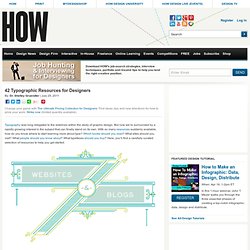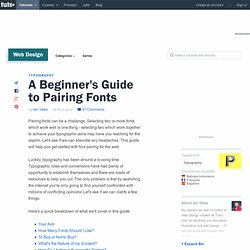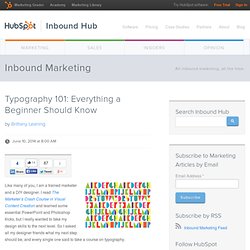

Type Resources. Typography was long relegated to the sidelines within the study of graphic design.

But now we’re surrounded by a rapidly growing interest in the subject that can finally stand on its own. With so many resources suddenly available, how do you know where to start learning more about type? Which books should you read? What sites should you visit? What people should you know about? Perhaps the most visited typographic blog today is I Love Typography (www.ilovetypography.com), which receives more than half a million visitors a month. Ellen Lupton’s book “Thinking with Type” has an excellent companion website (www.thinkingwithtype.com).
Typedia (www.typedia.com), a shared encyclopedia of typefaces, is multifaceted. Web typography: The future of typography on the web, web fonts. Typography” and “web” are two words that have never played well together.

During the 20-year history of the web, despite the radical improvements in computers and display technologies, fonts and type layout for the screen have remained almost unchanged. Change is coming, though. In fact, it’s already here, and you may have started noticing that some websites seem to be expanding their repertoire. The ability to add web fonts to any site is going to completely change the way you view design on the web. While the new trends in web typography are not just about the availability of new typefaces—in parallel to the rise of web fonts, web browsers have been adding new font and text styles—the lack of typefaces on the web undoubtedly has been the greatest obstacle. A Brief History of Web Typography Ever since Tim Berners-Lee made his first web page in 1990, designers have been dependent on the fonts available on the computer of the person viewing their work.
10 Free Fonts—Plus Free Font Download Tips. Designers know that finding the perfect font for a project can be an agonizing experience.

Letterforms have to be “just so,” and compromise on typographic quality is not an option. Throw tight budget into the mix and we inevitably turn to the web to search for free fonts. Perusing fabulous typography is usually a pleasure, but searching for a cool free font (that’s also licensed for commercial use) can be quite daunting on a deadline. It’s a formidable task to find fonts that are of superior quality in their letterforms, glyphs and kerning pairs. Type “free fonts download” into any search engine and the result is thousands of websites. Here are a few pointers for finding the best free fonts: Examples of Type Classification: script, western, vintage fonts, etc.
Most typefaces can be divided into four basic groups: those with serifs, those without serifs, scripts and decorative.

Over the years, typographers and typographic scholars have attempted to devise systems to more definitively organize typefaces — some systems have over a hundred different categories. A classification system can be helpful identifying, combining and choosing typefaces. While four categories are clearly inadequate for design professionals, hundreds become self-defeating. We have put together somewhat of a hybrid system of 15 categories based on the historical and descriptive nomenclature of the Vox system published in 1954 — and still widely accepted as the standard today.
Added to this, are 10 categories that are “fashion” based and show up remarkably often in Web-based, search engine requests. Historical and descriptive classifications Serif Type Styles Sans Serif Type Styles Script Type Styles Decorative. A Beginner's Guide to Pairing Fonts. Pairing fonts can be a challenge.

Selecting two or more fonts which work well is one thing - selecting two which work together to achieve your typographic aims may have you reaching for the aspirin. Let's see if we can alleviate any headaches. This guide will help you get started with font pairing for the web. Luckily, typography has been around a lo-oong time. Typographic rules and conventions have had plenty of opportunity to establish themselves and there are loads of resources to help you out. Here's a quick breakdown of what we'll cover in this guide: Your Aim Keep the essentials in mind. How Many Fonts Should I Use? How many fonts you throw into the mix is entirely up to you, but bear in mind the overall effect you're trying to achieve.
Make sure that there is some charisma in the group though; eight people with little to say just results in a toe-curling wait for the speeches.. Typography 101: Everything a Beginner Should Know. Like many of you, I am a trained marketer and a DIY designer.

I read The Marketer’s Crash Course in Visual Content Creation and learned some essential PowerPoint and Photoshop tricks, but I really wanted to take my design skills to the next level. So I asked all my designer friends what my next step should be, and every single one said to take a course on typography. So I decided signed up for a typography course at the Massachusetts College of Art and Design.
I figured I'd learn how to identify a good font from a bad one. What I didn't realize was that starting out small and paying attention to the details makes all the difference in the world when you're laying out an email, ebook, or image for social media. Every little change you make to a word or a body of text can make a huge difference in the overall piece. In fact, one of the only college courses Steve Jobs took was on calligraphy and typography, which he believed played a critical role in the success of Apple.